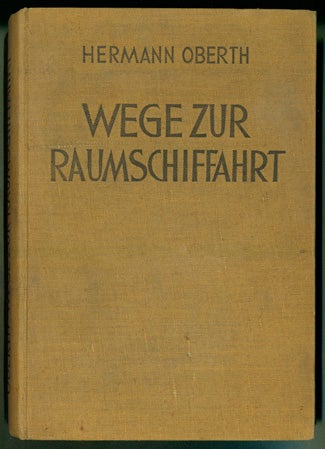
Wege zur Raumschiffahrt
Publisher Information: Munich: R. Oldenbourg, 1929.
Oberth, Hermann (1894-1989). Wege zur Raumschiffahrt. xi, 431pp. 4 plates. Munich & Berlin: R. Oldenbourg, 1929. 236 x 163 mm. Original cloth, front cover slightly warped. Fine copy. Publisher's blurb for Die Möglichkeit der Weltraumfahrt (1928), ed. Willy Ley, tipped to the front free endpaper.
Wege zum Raumschiffahrt was the first work to receive the REP-Hirsch International Astronautics Prize, which had been established in 1928 by French rocketry pioneers Robert Esnault-Pelterie and André-Louis Hirsch; the prize was awarded annually between 1929 and 1939. The purpose of the prize was to recognize "the best original theoretical or experimental works capable of promoting progress in one of the areas permitting the realization of interstellar navigation or furthering knowledge in a field related to astronautics" (Blosset, p. 11). In the epilogue to his book, Oberth acknowledged its receipt of the REP-Hirsch Prize and expressed his surprise and gratitude that a French organization "would award such a prize to a German . . . It is encouraging to see that science and education are able to bridge national differences" (p. [424]).
Oberth's Wege zum Raumschiffahrt began as a doctoral thesis on the rocket in interplanetary space, which he submitted to the University of Heidelberg in 1922. In his thesis Oberth set out to prove four propositions: (1) that the technology of the time permitted the building of machines capable of rising above the earth's atmosphere; (2) that these machines could attain velocities sufficient to prevent their falling back to earth, or even to escape the earth's gravitational pull; (3) that such machines could be built to carry human beings; and (4) that under certain conditions, their manufacture might be profitable. Oberth demonstrated that a rocket can operate in a vacuum and that it can surpass the velocity of its own exhaust; he also pointed out the superiority of liquid fuels in producing maximum exhaust velocity.
Oberth's thesis was rejected by the University of Heidelberg, so he published it commercially in 1923 under the title Die Rakete zu den Planetenräumen; a second, slightly enlarged edition appeared in 1925. In the 1929 third edition, which is over four times larger than the first, Oberth "reported most of [his] theories on space travel . . . described manned space travel in detail, proposed the inclined trajectory towards the east for ascending space ships, investigated the relationships between consumption of propellant and gain of energy, commented on most of the errors in the literature of the day concerning rockets, and finally, described an electrostatic space ship" (Oberth, p 136). Oberth dedicated the work to Fritz Lang and Thea von Harbou, director and writer respectively of Frau im Mond, one of the world's first serious science fiction films. Oberth had served as a consultant on the film, which was the first to present the basics of rocketry to a mass audience.
Some of Oberth's findings were anticipated by those of Goddard and of Tsiolkovsky; however, their work went largely unheralded, while Oberth's was greeted enthusiastically in Germany by a band of devotees that eventually became the Verein für Raumschiffahrt (Society for Space Travel). This in part explains why, when war came in 1939, Germany was able to quickly organize an efficient and competent rocketry research team capable of producing advanced weapons such as the V-2. After the war German rocket technology was transplanted into the United States' rocketry and space programs, greatly enhancing their development. Blosset, "Robert Esnault-Pelterie: Space Pioneer," in Durant & James, First Steps toward Space (1974), pp. 5-21. Oberth, "My Contributions to Astronautics," in ibid., pp. 129-140. Von Braun & Ordway, Hist. Rocketry & Space Travel, pp. 57-59.
Book Id: 40948Price: $1,250.00
